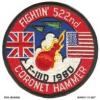Search the Community
Showing results for tags 'Grant'.
-
I'm far from being a regular in the armour section. So this may have been posted before. Not one, not two, but three Grant tanks being recovered for a restoration team in Australia. Lots of detail can be seen, so it should make someone happy. Enjoy. I liked it. BTW, there will be adverts. https://www.youtube.com/watch?v=5baPdQHbCkA
-
Hi all, I have just bought a set of decals in 1/35 for M3 Lee and Grant tanks by Echelon (352015) primarily because it has a machine which it says is from the Warwickshire Yeomanry in North Africa in 1942. The tank has the name "Chicago" painted on the turret sides but there are no other identifying markings such as the serial number. I have tried to search the internet for any corroborating pictures or information to back the profile on the instructions and was hoping that somebody on here could point me in the right direction and at least let me know whether she was a Grant I or II. Many thanks in advance for any help. Craig. 🇺🇦
-
This will be my contribution to this GB, this will be the first tank I have built in over 10 years so thought I would start with something nice and easy.
-
Finally done. Miniart 1/35 - Grant MkII plus metal barrel. Painted with MRP. Great kit, although - as Miniart is - over-engineered. Built more as a training ground, for various techniques. But overall I guess it turned out quite all right. Thanks for all comments! Appreciate any tips. Bart.
- 13 replies
-
- 41
-

-

-

British Tank M3 Grant "The English Patient"
THEscaleSHOW posted a topic in Work in Progress - Armour
Hello all While the Churchill AVRE has got its SCC 15 base coat and is still drying, I would like to show one of my other projects today, which I am working on parallel to the other models. My planned vignette will show a half-destroyed Grant in North Africa - therefore the title "The English Patient". 🤕 In my imagination the damage was caused by a shell exploding inside the tank close to the side hatch and bent some riveted plates. In addition, a few rollers were also burnt out. My plan is, as in the film, to leave one part destroyed and one intact 🔥 Have fun with the first pictures! MD Vallejo Putty works also fine in this case open hatches first damages on the plates fuel cup modifications Next steps are the boggies and PE- 66 replies
-
- 16
-

-
Grant Mk.I (35276) 1:35 MiniArt via Creative Models In the years before WWII America realised that they were lagging behind in respect of armour, a fact that became especially clear when Germany came out from under the Versailles treaty to show off and then use their new tanks and Blitzkrieg tactics. The M3 Lee was conceived in 1940 as a medium tank carrying a powerful 75mm gun, partly for manning by their own crews, but also because Britain had requested a large number of tanks to make good their losses from Dunkirk. The Lee was a decent tank but suffered from a high silhouette and limited traverse of the sponson-mounted 75mm gun, but was still widely used. In British service it was known as the Lee if it was fitted with the original American turret, or the Grant when using the lower-profiled British specification turrets. The Grant eschewed the mini-turret on the commander's cupola that resulted in a reduction in height and a minor simplification of construction and maintenance for very little loss in flexibility, due to the coaxially mounted Browning machine gun in the turret. It was used primarily in Africa and the Pacific theatres where the 2nd line equipment seemed to be fielded (for the most part) by the enemy, and against the Japanese who were far behind with their tank designs and tactics. The Kit MiniArt began 2019 with a new tooling of the M3 Lee and have expanded their range by adding new parts as they go along. The primary changes in this boxing are the inclusion of a new cast turret with no machine-gun turret-let on top, and the inclusion of British equipment inside and around the exterior. We've come to expect great things from miniArt's new kits and of course this one is no different with a ton of detail included The original release we reviewed here was the full interior kit, now for those of us who dont build full interior kits (like myself) we have the great kit without all of that stuff. The box is standard MiniArt fare with an attractive picture from their usual artist, and inside are a huge number of sprues of varying sizes with 54 sprues in grey styrene, a single sprue in clear, a fret of Photo-Etch (PE) brass, decal sheet, 2 sprues of equipment/tarps; and the instruction booklet with painting guide at the rear completing the package. Construction begins with the vehicle floor onto which the transmission and final drive assemblies are fixed. The rolled lower glacis part is also added, and the final drive bell housings that are incorporated into the sidewalls mate with these to complete the shape of that area. The side plates are added and then the top sponsors. To the rear the engine compartment is built up, the doors are fitted along with the exhausts. At the front additional plates over the drive shafts are added. The big 75mm gun and substantial casemate are built up next for fitting into the hull front and the curved splinter shield that allows 14o of traverse to either side to counter any errors in position from the driver or enemy movement. The breech is surrounded by a shield. The various hatches can be posed open or closed, however as there is no interior best close them up! The bow machine gun is actually a twin mount with two .30 cal M1919s firing through a hatch near the port sponson. The rest of the hull is then built up in much the same manner as the real thing, but with glue and the rivets only there for show. Two large bins for the rear are then built up. When we reach the engine deck there are two large panels, the smaller of them having PE grilles and more filler caps, with both of them covered in small PE tie-down lugs. The rear of the deck overhangs the hull and a small armoured "skirt" protects the tops of the exhausts from stray rounds where PE brackets are used to hang the aft lights. The completed deck is then covered with pioneer tools and their PE tie-downs, plus the towing cables that you need to source yourself to go with the plastic eyes at each end. A scrap diagram shows their location and how to fix the PE straps to the tie-downs and eyes, with a length of 145mm suggested. At this stage the majority of the hull is built, but it is likely to fill with rain until the roof is fitted. The stiffening plates to the lower glacis are also glued to the hull and then the roof is made up from a large main part that is stiffened with a number of ribs, and an extra section is attached to the side with a small periscope in the middle. The three square access doors for the crew can all be posed open or closed with latches and small viewing hatches within that can also be posed open. After fitting the armoured cover to the main gun's periscope and a few grab handles, you get to build up the running gear. Aren't you lucky? The Grant's suspension is very similar to the Sherman's with two fat wheels on a bogie with a return wheel at the top, and there are three per side. The wheels with their moulded-in rubber tyres are attached to the bogies via swing-arms that pivot inside the cast bogie with an additional arm linked to the compressible rubber towers. Before the front of the bogie is fitted the return roller is installed so it is trapped between its two bearings. Repeat that six times and then make up the idler wheels, which have PE edges and separate hub caps. The bogies are attached to the sides of the hull on their mounting plates, and two stiffeners are added to the top of each one, while the idler wheels are attached to their axles on the adjustable tensioners. At the front the drive sprockets are made up from two parts with an internal collar allowing them to remain mobile if you're sparing with the glue. A short break has you fitting the driver's hatch and optional clear window with a PE wiper blade, plus a couple of towing eyes with shackles under the glacis and some truly tiny parts in plastic and PE between them. Tracks. Love 'em or loathe 'em, they're a necessary part of most tanks and you have to do them eventually. There are 79 track links per side, and each link is made up from four parts. The pads are split to accommodate the links between them, and this is a little fiddly. Mike built a test section up with the interior kit, each link is good looking with fine detail at the ends, and they are flexing nicely as per the real thing. It'll take some time to complete them, but they will be excellent as long as you're careful with preparation and the glue. With the tracks in place, the side skirts can be installed and the additional stowage boxes can be fabricated from their parts and attached to the hull with PE brackets, their shape conforming to the surfaces that they are placed on. The side skirts are finished off with mudguards at the rear by boxing in the tops of the track runs. The rest of the pioneer tools are bracketed to the hull along with the front headlights and their PE protective cages, the former having PE tie-downs and brackets holding them down. You will need to find some thin wire to link the headlamps to the gland that takes the cable inside the hull, then the single-part main gun barrel is nipped from the sprues, has its seamlines removed and is joined to the optional two-part blast-bag that has excellent realistic-looking canvas wrinkle and sag moulded in. We're still not quite ready for the turret though, as there are a number of PE parts stretching the length of the side-skirts which are used to hang additional stowage in the real thing. These fit onto small depressions on the sides of the hull, and scrap diagrams show the correct way to fold the perpendicular front sections. Now you can start the turret, most of which is held within the upper part, and that has some very nice casting texture moulded into it that should look great under a few coats of paint. The frames for the small hatches are first to be added, then the hatches themselves are fitted in the open or closed position with small stays holding them at the correct angle for the former. The breech is started by joining the two main parts together, adding the surround, the coax machine gun, then setting it aside while the mantlet and elevation mechanisms are made up. The barrel fits to the mantlet and the turret halves joined, the aerials are then added. Next up is the reduced height British spec cupola with grab handles and a choice of open or closed hatch with periscope in the port door. The commander's .30cal weapon is mounted on a curved fitting on the front of the turret and is fitted with a drum magazine that has moulded-in bullets plus a separate short length that feeds into the breech, sandwiched between the two end-caps with built in mounting frame. A studded bezel is installed in the top rim along with the hatches. The turret can then be fitted. There are additional parts for British Army specific stowage included in the box, which is good to see as a personalised model often looks better than a basic kit. Their locations and colour are shown on separate colour diagrams that can be found at the front of the painting diagrams. Decals There are a generous 7 options provided for the modeller on the decal sheet, split between camouflaged, green and sand coloured vehicles, as the Grant and Lee served mainly in warmer climes. Considering this is an armour kit the sheet is relatively large due to the number of options. From the box you can build one of the following: British Army, Royal Armoured Corps. 3rd Royal Tank Regiment, Egypt 1942. British Army, unidentified unit, Middle East 1942. British Army, 7th Armoured Division, El Alamein, July 1942 British Army, unidentified unit, North Africa 1942. British Army, Royal Scots Grey, 4th Armoured Brigade, Western Desert, Oct 1942. British Army, 7th Armoured Division, El Alamein, Oct/Nov 1942 Polish Land Forces, 2nd (Warsaw) Polish Armoured Brigade, Palestine 1943. Decals are by DecoGraph, and have good registration, sharpness and colour density, with a thin matt carrier film cut close to the printed area Conclusion This is a wonderfully detailed kit of the Grant as it was supplied to and used by the British Army. The detail incorporated in styrene even without the interior is phenomenal and the addition of the PE parts gives the modeller all the shackles for their pioneer tools, which are usually included in aftermarket PE sets. A really impressive piece of plastic engineering. Very highly recommended. Review sample courtesy of
-
M3 Lee Update Set (36373 for Takom) 1:35 Eduard Takom brought out their first of a growing range of M3 Lee kits late 2017 (reviewed here), which is filling out nicely, and brings a lot more detail to the party than the ageing Academy kit. As usual with Eduard's Photo-Etch (PE) and Mask sets, it arrives in a flat resealable package, with a white backing card protecting the contents and the instructions that are sandwiched between. The single brass fret contains parts to replace the front fenders with more in-scale parts, which have the stiffeners added, as well as the bracket that holds the kit's lamp cluster parts. A number of brackets and tie-downs are supplied to improve the realism of the pioneer tools, which requires some minor modifications to the tools so that they fit their new brackets. The side doors have hasp and staple locks added, as do the other hatches, and the fuel cap is fitted with a retaining chain, while the tow-rope is fitted with new tie-downs, and the rear-facing mesh grille on the engine deck is scrubbed of moulded-in detail before a PE part replaces it. Another finer mesh panel fits to the forward section of the engine deck, replacing the kit part, which is also PE. The turret rear is fitted with a couple of additional panels with brackets, but check your references about these parts, as they aren't visible on many of the examples I've seen. An extra track stowage area is folded up into a tray, with a pair of straps strung across to keep the contents safe, which is then attached to the glacis plate with a triangular stiffener helping keep it in place. Review sample courtesy of
-
Hi all, not sure if it's normal to have 3 separate threads on the go for one subject, but I'll give it a go anyway and worry about the fallout if any after Indeed, this is the 3rd part of my project to show a 3RTR M3 Grant 'at leaguer' on the evening of 1st September 1942, during the Battle of Alam Halfa. Having never made a diorama base ever at all, I have relied heavily on other threads shared here, as well as You-Tube clips to show me the way. This thread, then, is my own journey of discovery, with all its pitfalls and set-backs; hopefully someone will find it of interest. For some background I am trying to build a diorama of this particular day during this battle, as in the course of my familiy history research some years ago I learned that my father had taken part in it as a driver with the 3rd Royal Tank Regiment, and been wounded in action. The 1st September this year will mark the 75th anniversary of that event, something I felt I had to recognise, hence this diorama. The tank and figures WIPs are described separately: tank WIP here and figures WIP here, should you be sufficiently curious to wish to take a look. So, the diorama base - a photo frame 10 x 8 - not sure if it's too big for the whole thing, but I am going with it anyway. Glass removed and safely set aside for some future purpose yet to be determined . The edges were built up to the desired profile with thin fibre-board, some packaging remnant from something I've long-since forgotten. The basic topology was then built up with expanded polystyrene shaped with a sharp knife, and glued in with plenty of PVA. Cocktail sticks were used to persuade the more reluctant pieces to lie flat as requested: In the time-honoured way, I decided to use Das air-drying clay - mainly because I had it readily to hand: I spread this over the polystyrene, with some water to get the Das to flow a bit more freely: Now for the sand. I read in another thread on here, that someone recommended 'Chinchilla dust' - no, I hadn't ever heard of it either. But I figured £3.50 for a big bag of the stuff from my local pet store was worth a punt, and indeed it has a very convincing sandy look. However, from my research of the geographical aspects of the battle told me that the area was rather stony as well as sandy, with some sparse vegetation. With that in mind, I mixed in a handful or so of fake coal - the kind beloved of railway modellers: With the Das still wet from being laid down, I liberally sprinkled this mixture over the top of it, from about 12 inches up, then gave it a bit of a press down. Tapping the framework to shift the loose material left me with this: That's as far as I got with it today, but I have to say to my hopelessly inexperienced eye it looks pretty good. Hope this is of interest to someone!
-
From their facebook page;
-
Here's a recent discovery in the attic that brought a smile to my face. I reckon these must have been done around 1984/1985/1986 when I was in my early teens http://flic.kr/p/jj58cR http://flic.kr/p/jj4CQv http://flic.kr/p/jj5e76 http://flic.kr/p/jj72WA Pretty rubbish really, but brought back some great memories Happy days Justin H Oops I've posted in WIP not RFI, mods please move if necc. Not used to armour forums I suppose!
- 7 replies
-
- Mardertamiya
- hanomag
-
(and 3 more)
Tagged with:







